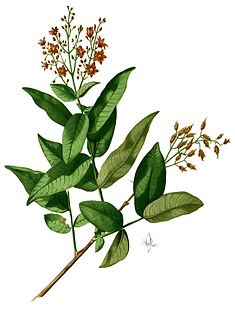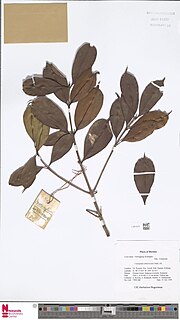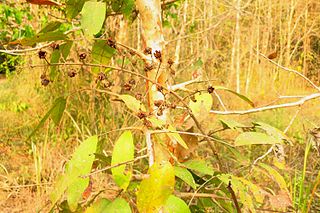
Cratoxylum is a genus of flowering plants in the family Hypericaceae, native to tropical Asia. The generic name is from the Greek meaning "strong wood", referring to the timber.

Cratoxylum arborescens is a plant in the family Hypericaceae. The specific epithet arborescens is from the Latin meaning "tree-like".

Cratoxylum cochinchinense is a plant now placed in the family Hypericaceae. The specific epithet cochinchinense is from the Latin meaning "of Cochinchina". In Vietnamese C. cochinchinense is usually called thành ngạch nam or lành ngạnh nam, other names include: hoàng ngưu mộc, hoàng ngưu trà and đỏ ngọn.

Cratoxylum maingayi is a plant in the family Hypericaceae. It is named for the botanist Alexander Carroll Maingay.
Euthemis minor is a plant in the family Ochnaceae. The specific epithet minor is from the Latin meaning "small", referring to the species' smaller size when compared with E. leucocarpa.
Licania splendens is a tree in the family Chrysobalanaceae. The specific epithet splendens is from the Latin meaning "shining", referring to surfaces of the dried leaves.
Mastixia macrocarpa is a tree in the family Nyssaceae. The specific epithet macrocarpa is from the Greek meaning "large fruit".
Allantospermum borneense is a tree in the family Irvingiaceae. The specific epithet borneense is from the Latin meaning "of Borneo".
Xanthophyllum ellipticum is a plant in the family Polygalaceae. The specific epithet ellipticum is from the Latin meaning "elliptical", referring to the leaves.
Combretocarpus is a monotypic genus of tree in the Anisophylleaceae family. The generic name combretocarpus is from the Greek, referring to the resemblance of its fruit to that of the genus Combretum. As of April 2014 The Plant List recognises the single species Combretocarpus rotundatus.
Dacryodes incurvata is a tree in the family Burseraceae. The specific epithet incurvata is from the Latin meaning "bending inward", referring to the leaflet margin.
Dacryodes longifolia is a tree in the family Burseraceae. The specific epithet longifolia is from the Latin meaning "long leaf".
Parastemon grandifructus is a tree in the family Chrysobalanaceae. The specific epithet grandifructus is from the Latin meaning "large fruit".
Ellipanthus tomentosus is a plant in the family Connaraceae. The specific epithet tomentosus is from the Latin meaning "thickly covered with hairs", referring to the leaves.
Mastixia cuspidata is a tree in the family Nyssaceae. The specific epithet cuspidata is from the Latin meaning "sharp-pointed", referring to the leaf apex.
Mastixia pentandra subsp. scortechinii is a subspecies of Mastixia pentandra. It is a tree in the family Nyssaceae. It is named for the botanist Benedetto Scortechini.
Mastixia trichotoma is a tree in the family Nyssaceae. The specific epithet trichotoma is from the Greek meaning "three parts", referring to the three-branched inflorescence.
Euthemis leucocarpa is a plant in the family Ochnaceae. The specific epithet leucocarpa is from the Greek meaning "white fruit".
Lithocarpus ewyckii is a tree in the beech family Fagaceae. It is named for D.J. van Ewijck van Oostbroek en De Bilt of the Dutch Colonial Service.
Lithocarpus gracilis is a tree in the beech family Fagaceae. The specific epithet gracilis is from the Latin meaning "slender", referring to the twigs.






